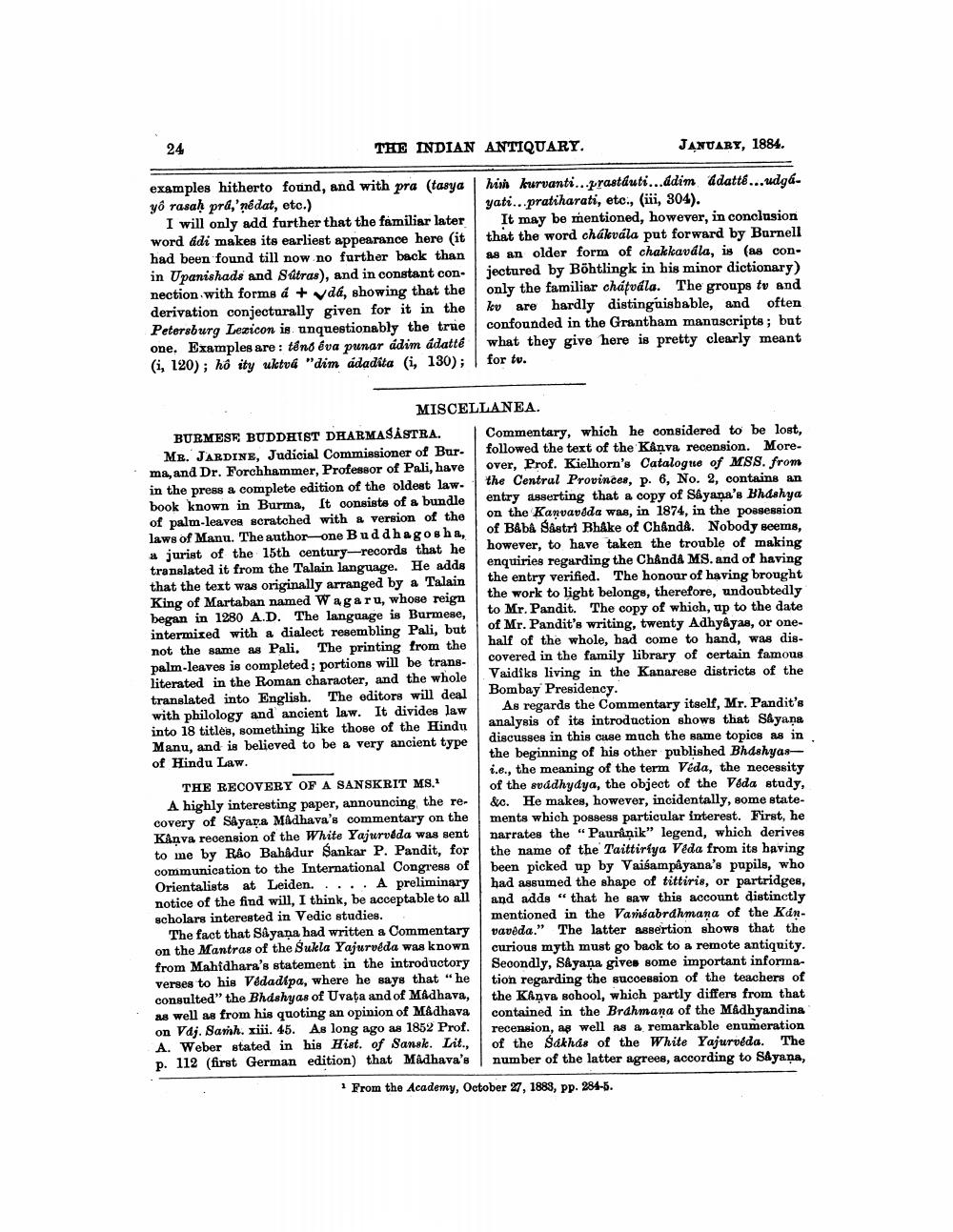________________
24
THE INDIAN ANTIQUARY.
JANUARY, 1884.
examples hitherto found, and with pra (tasyahin kurvanti...prastáuti...ddim ddatte...udga. yô rasaḥ pra,' médat, etc.)
yati...pratiharati, etc., (ii, 304). I will only add further that the familiar later It may be mentioned, however, in conclusion word ddi makes its earliest appearance here (it that the word chákvala put forward by Burnell had been found till now no further back than as an older form of chakkavála, is (as conin Upanishads and Sútras), and in constant con- jectured by Böhtlingk in his minor dictionary) nection with forms á + vdá, showing that the only the familiar chátvála. The groups tv and derivation conjecturally given for it in the kevare hardly distinguishable, and often Petersburg Lexicon is unquestionably the true confounded in the Grantham manuscripts; but one. Examples are : têns éva punar ádim adatté what they give here is pretty clearly meant (i, 120); ho ity uktva "dim adadita (i, 130); for tu.
MISCELLANEA. BURMESE BUDDHIST DHARMASÅSTRA. Commentary, which he considered to be lost, MR. JARDINE, Judicial Commissioner of Bur. followed the text of the Kanva recension. More ma, and Dr. Forchhammer, Professor of Pali, have over, Prof. Kielhorn's Catalogue of MSS. from in the press a complete edition of the oldest law. the Central Provinces, p. 6, No. 2, contains an book known in Burma, It consists of a bundle entry asserting that a copy of Sayana's Bhashya of palm-leaves scratched with a version of the on the Kanvaváda was, in 1874, in the possession laws of Manu. The author-one Buddhagosha,
of BAba Sastri Bhake of Chånda. Nobody seems, a jurist of the 15th century-records that he however, to have taken the trouble of making translated it from the Talain language. He adds enquiries regarding the Chåndå MS, and of having that the text was originally arranged by a Talain the entry verified. The honour of having brought King of Martaban named Wagaru, whose reign
the work to light belongs, therefore, undoubtedly began in 1280 A.D. The language is Burmese,
to Mr. Pandit. The copy of which, up to the date intermixed with a dialect resembling Pali, but
of Mr. Pandit's writing, twenty Adhyâyas, or onenot the same as Pali. The printing from the
half of the whole, had come to band, was dispalm-leaves is completed; portions will be trans- covered in the family library of certain famous literated in the Roman character, and the whole
Vaidiks living in the Kanarese districts of the translated into English. The editors will deal Bombay Presidency. with philology and ancient law. It divides law As regards the Commentary itself, Mr. Pandit's into 18 titles, something like those of the Hindu analysis of its introduction shows that S&yana Manu, and is believed to be a very ancient type
discusses in this case much the same topics as in of Hindu Law.
the beginning of his other published Bhashyas
i.e., the meaning of the term Veda, the necessity THE RECOVERY OF A SANSKRIT MS.
of the suddhydya, the object of the Voda study, A highly interesting paper, announcing the re- &c. He makes, however, incidentally, some statecovery of Sayar.a Madhava's commentary on the ments which possess particular interest. First, he Kanva recension of the White Yajurvéda was sent narrates the “Pauriņik" legend, which derives to me by Rao Bahadur Sankar P. Pandit, for the name of the Taittiriya Veda from its having communication to the International Congress of been picked up by Vaišampâyana's pupils, who Orientalists at Leiden. ... A preliminary had assumed the shape of tittiris, or partridges, notice of the find will, I think, be acceptable to all and adds " that he saw this account distinctly scholars interested in Vedic studies.
mentioned in the Vamsabrdhmana of the KanThe fact that Sayana had written a Commentary vaveda." The latter assertion shows that the on the Mantras of the Sukla Yajurvéda was known curious myth must go back to a remote antiquity. from Mahidhara's statement in the introductory Secondly, Sayaņa gives some important informaverses to his Védadipa, where he says that "he
tion regarding the succession of the teachers of consulted" the Bhdshyas of Uvata and of Madhava, the Kaņva school, which partly differs from that as well as from his quoting an opinion of Madhava
contained in the Brahmana of the Madhyandina on vaj. Samh. xii. 45. As long ago as 1852 Prof. recension, as well as a remarkable enumeration A. Weber stated in his Hist. of Sansk. Lit., of the sakhas of the White Yajurvéda. The p. 112 (first German edition) that Madhava's number of the latter agrees, according to SAyana,
From the Academy, October 27, 1883, pp. 284-5.




